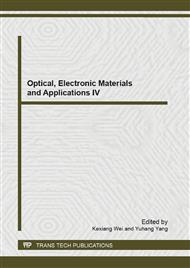[1]
Abbey C, Joos G. Effect of low voltage ride through (LVRT) characteristic on voltage stability[C]//IEEE Power Engineering Society General Meeting, San Francisco, CA, Jun 12-16, 2005: 1901-1907
DOI: 10.1109/pes.2005.1489659
Google Scholar
[2]
Iñigo Martinez de Alegríaa, Jon Andreua, José Luis Martína etal. Connection requirements for wind farms: A survey on technical requirements and regulation[J].Renewable and Sustainable Energy Reviews, 2007, 11(8):1858–1872
DOI: 10.1016/j.rser.2006.01.008
Google Scholar
[3]
Mohseni M, Islam S, Masoum M.A.S. Low voltage ride-through requirements at the PCC versus wind generator terminals[C]//20th Australasian Universities Power Engineering Conference, Christchurch, New Zealand, 2010:1-6
Google Scholar
[4]
Jesus Lopez, Pablo Sanchis, Xavier Roboam, et al. Dynamic Behavior of the Doubly Fed Induction Generator During Three-Phase Voltage Dips[J]. IEEE Transactions on Energy Conversion, 2007, 22(3):709-717
DOI: 10.1109/tec.2006.878241
Google Scholar
[5]
LI Qin, ZHANG Xing, YANG Shuying, et al. Dynamic Behavior of DFIG Rotor During Low Voltage Ride-Through[J]. Proceedings of the CSU-EPSA, 2010, 22(5):19-24
Google Scholar
[6]
Vicatos M S, Tegopuios J A. Transient state analysis of a doubly-fed induction generator under three phase short circuit [J]. IEEE Transaction on Energy Conversion,1991,6(1):62-68
DOI: 10.1109/60.73790
Google Scholar
[7]
YANG Shuying, ZHANG Xing, ZHANG Chongwei, et al. Electro-magnetic Transition of Doubly Fed Wind Turbines Initiated by Voltage Dip[J]. Automation of Electric Power System, 2008, 32(19):85-90
Google Scholar
[8]
ZHANG Jianhua, CHEN Xingying, LIU Haoming, et al. Three-phase short-circuit analysis for double-fed wind-driven generator and short-circuiter maximal resistance calculation[J], Electric Power Automation Equipment, 2009, 29(4): 6-10
Google Scholar
[9]
Aoyang Han, Zhe Zhang, Xianggen Yin, et al. Study of the Factors Affected the Rotor Over-current of DFIG during the Three phase Voltage Dip[C]//Third International Conference on Electric Utility Deregulation and Restructuring and Technologies Power, Nanjing, China, 2008:2647-2652
DOI: 10.1109/drpt.2008.4523858
Google Scholar
[10]
LI Hui, ZHAO Meng, YE Renjie, TANG Xianhu, LIU Zhixiang. Evaluation and analysis of transient current of a DFIG wind generation system under grid fault[J].Electric Machines And Control, 2010, 14(8):46-51
Google Scholar
[11]
Shen Hong. Studies on Integrated Variable-Speed Constant-Frequency Wind Turbine Models and The Application[D].Beijing: China Electric Power Research Institute, (2003)
Google Scholar
[12]
Yin Ming,Li Gengyin,Zhou Ming,et al. Analysis and Comparison of Dynamic Models for the Doubly Fed Induction Generator Wind Turbine [J]. Automation of Electric Power System,2006,30(13):22-27 (in English)
Google Scholar
[13]
Morren J, de Haan, S W H. Short-Circuit Current of Wind Turbines With Doubly Fed Induction Generator [J]. IEEE Transactions on Energy Conversion, 2007, 22(1):174-180
DOI: 10.1109/tec.2006.889615
Google Scholar
[14]
Sheng Hu, Xinchun Lin, Yong Kang, et al. An Improved Low-Voltage Ride-Through Control Strategy of Doubly Fed Induction Generator During Grid Faults[J]. IEEE Transactions on Power Electronics, 2011,26(12):3653-3665
DOI: 10.1109/tpel.2011.2161776
Google Scholar
[15]
YANG Shuying. Converter and Control for Doubly Fed Induction Generator-Based Wind Power Generation[D]. Heifei:Heifei University of Technology, (2007)
Google Scholar
[16]
Hu jiabing. Investigation on the Ride-Through Operation of DFIG-based Wind Power Generation Systems During Grid Fault—Basic Theory and Key Technology[D]. Zhejiang : Zhejiang University, (2009)
Google Scholar
[17]
LIU Hongbo, MU Gang, YAN Gangui, et al. A Convolution Method for Calculating the Trajectory Sensitivity Based on Measured Trajectory[J]. Automation of Electric Power System, 2007, 31(5): 13-17
DOI: 10.1109/pes.2007.386087
Google Scholar
[18]
CHEN Jianhua, WU Wenchuan, ZHANG Boming, et al. A Parameters Estimation Method for Generators Using Trajectory Sensitivity[J]. Automation of Electric Power System, 2010, 34(23): 21-24+41
Google Scholar
[19]
HAN Rui, ZHENG Jinghong, ZHU Shouzhen,et al. Step Identification of Synchronous generator parameters based on sensitivity analysis[J].Electric Power Automation Equipment, 2012, 32(5):74-80
Google Scholar
[20]
ZHANG Junfeng, MAO Chen-xiong, LU Jiming, et al. Direct power control strategy of doubly fed induction generator[J],Electric Power Automation Equipment, 2006, 26(4): 31-35
Google Scholar


